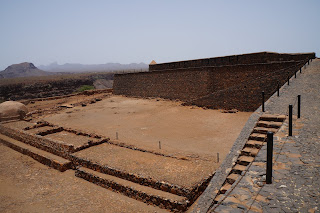First thins first. A view of Cidade Vehla, the first settlement in Cape Verde. Charming and well preserved, including the first street - the street of the banana! This was a very important center for Portuguese traders, linking Europe, Africa and America, including during the slave trade. Vasco de Gama and Christopher Colombus stopper over during some of their travels. The city was attacked many times by pirates, which finally resulted in the city losing its status to Praia, the eventual capital.
There is an imposing fort overlooking the city. Of course, there are many churches too. Most of them were involved in the slave trade, as a converted slave would fetch a higher price.
In this context, the most disturbing monument is certainly the pillory, in the middle of the town square. This is where slaves were chained, punished or sold.
In Praia, the capital, we can see many colonial buildings. The city has a nice old town, with a long pedestrian street, a market, and the noticeable presence of the Chinese traders.
The newer Palace of the Governement and the National Assembly were built by the Chinese. The "new colonialists" are no comparison to the old ones. In the northern corner of the island, we visited a concentration camp built in the 1930s by the Portuguese to jail political opponents from their African colonies. Some would call them "terrorists" other "patriots". Different points of views, but a very dark place.
Let's finish on a lighter note: the beautiful beach in Tarrafal.
The next island is Fogo, the "volcano island". This is the most impressive island by far. The whole island rests on the slopes of the volcano. Even the airport strip is a bit scary. The volcano dominates everything. The ascension there is quite impressive!
There is a hige crater, and inside the crater, there are new volcanic cones. Yet, there is life inside the crater and close to the cones.
Volcanic soil is apparently very rich and seems to be ideal for grapes. The white wine produced in Fogo is the best in Cape Verde. Interesting that such a sweet wine can come from inside a volcano.
Lava can be beautiful. It takes different shapes and moves in different ways.
But lava is also very distructive. Fogo erupts quite regularly, every twenty years. The last eruption took place in October 2014. This time the flow of lava went directly towards the two little villages inside the crater, destroying them completely. Nowadays, only the rooftops are visible. The inhabitants were relocated outside of the crater, but many of them are already starting to come back and rebuilding their old houses...
Outside of the crater, the dark volcanic color dominates: even the beach sand is dark!
Maybe to compensate for this darkness, the buildings are very colourful. A beautiful contrast.















Aucun commentaire:
Enregistrer un commentaire